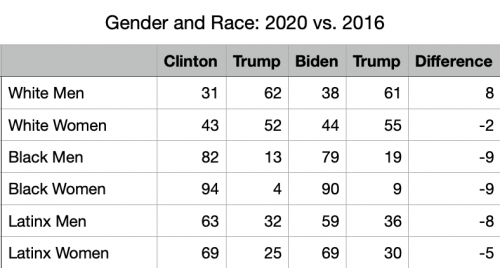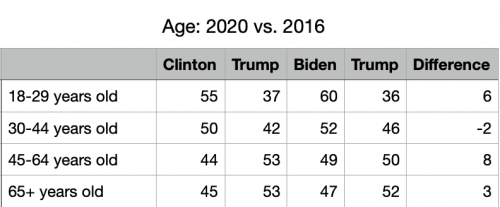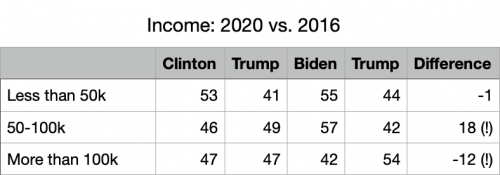After an election, people get right down to the business of trying to influence the new administration (or they don’t). One way to do that is to claim to represent some group of voters who ‘delivered’ the election to the winner. And Joe Biden will be no exception to this trend.
Indeed, the think pieces started rolling in as soon as the networks called it for Biden. Bernie Sanders claimed progressives delivered the win, and Alexandria Ocasio-Cortez agreed, arguing further that moderate Democrats largely failed. Moderates in turn blamed progressives for their own failures. Many commentators argued Democrats should ‘thank a black woman,’ while some praised Stacey Abrams in particular. And so on.
What should we make of all this? Which voters won the election for Biden?
Method of Analysis
Here’s how I’m going to answer those questions. I’ll compare the 2020 election results to results from prior elections, especially 2016. And then I’ll look at which groups of voters moved from Republican to Democratic. Good data here should show who proved decisive for Biden’s win, i.e., whose votes changed the outcome from 2016 to 2020.
To get at those votes, I’ll look at exit polls and actual returns. For most of the data, I’ll use numbers from the New York Times (see the caveat at the bottom of the post for notes on the ultimate source for 2020 information). I’ll also use data from CNN where I find the NYT data inadequate or incomplete.
I think it’s a good method, but it’s not perfect. Some groups of voters – particularly young progressives, lower income voters, black voters, et al. – lean Democratic in every election. And so, they remained a large part of Biden’s coalition, even if they didn’t provide the decisive votes. (Of course, they still may have provided the decisive votes anyway. We’ll look at the evidence and find out.)
Biden’s Key Voters
So, let’s take a look at the evidence. There are lots of groups to work through, so I’ll divide each into a section.
Gender and Race
We’ll start with gender and race. Here’s a comparison on gender between 2016 and 2020.

And one on race.

And, finally, the combination of gender and race.

I’ll note here that in each table above, readers should look most closely at the column on the right. That column shows the difference between 2016 and 2020, i.e., the vote that shifted toward (or away from) Democrats. Higher positive numbers here represent the voters who delivered for Biden.
The upshot? Biden did a bit better than Clinton with men. But he especially did better with white men. Why? That’s the question. People who claim misogyny explains why Clinton was so unpopular in 2016 probably see vindication in these numbers.
On the other hand, Biden did worse than Clinton with everyone except white men. These data clearly count against explanations citing black women as the key demographic delivering for Biden. But the same data point to increased turnout of young voters – especially women – in Georgia. And so, the ‘Stacey Abrams’ thesis fares better than the more general ‘thank black women’ thesis. But not too much better. Even in Georgia, Biden bested Clinton primarily among white men. Abrams likely impacted turnout far more than voter choice.
Age
Let’s move on to age. Here’s the same comparison.

Biden greatly improved on Clinton’s performance with young voters, despite the fact that Democrats almost always win the group. This lends some support to Bernie Sanders and AOC. But Biden also improved with voters age 45-64 (and, to a lesser extent, 65+), a more difficult demographic for Democrats. This in turn lends some support to moderate Democrats like Conor Lamb. The debate between moderates and progressives, then, might be a wash.
Income
The data on income are potentially more interesting than what we find on age. In particular, we find much larger differences between 2016 and 2020. Let’s take a look at two tables. The first divides voters into three income bands, while the second divides voters into five. I’ve added some handy exclamation points to show the largest differences.


Two things stand out here. First, Biden greatly improved over Clinton with voters making $50,000-100,000 per year. He also improved a fair bit with voters making between $30,000 and $50,000. On the best definitions we have available, these are working-class voters.
Second, Biden did much worse than Clinton with voters making $100,000 or more per year, but especially voters making between $100,000 and $200,000. (Voters who make more than $200,000 appear to mostly not care who wins elections.) While we can speculate in various ways, it’s likely many of the voters in the 100-200k camp benefited from Trump’s tax cuts.
Conclusions
Based on a comparison between the 2020 exit polls to prior exit polls, the key groups who delivered the election to Biden are: men, specifically white men, specifically ones age 45-70, specifically ones who haven’t graduated from college. In addition to white men, working-class voters and young progressives played a noticeable role. These are the voters who delivered the election to Biden.
Self-Serving Claims
In case it’s not clear by now, I think all the perspectives I outlined at the beginning of this article are based on self-serving, motivated reasoning. The people I cited aren’t looking carefully at the evidence and answering the question in the heading of this post honestly. Conveniently, all of them attribute Biden’s win to some group of voters they (purport to) represent or value.
That’s not such a great way to answer the question. When we set the self-serving claims aside, we can draw some reasonably clear inferences.
A Caveat
Of course, everything I’ve written here assumes the exit polls are (reasonably) accurate. As far as I can tell, they are. But – for anyone living on Mars – we’re in the middle of a pandemic. Polling companies struggled mightily with exit polling this year, given the large number of people who voted by mail or otherwise voted early.
In fact, there were two exit polls in 2020. One by Edison Research and another by the AP. I’ve chosen to use the Edison numbers for 2020 because the AP numbers appear to have obvious flaws. But even Edison’s numbers leave me with less confidence than exit polling from 2016 and previous election cycles.
And so, the things I’ve written here are only as good as the numbers they’re based on. But anyone going against the numbers needs to provide evidence or broader reasoning. And that evidence or reasoning needs to move beyond the anecdotal.
